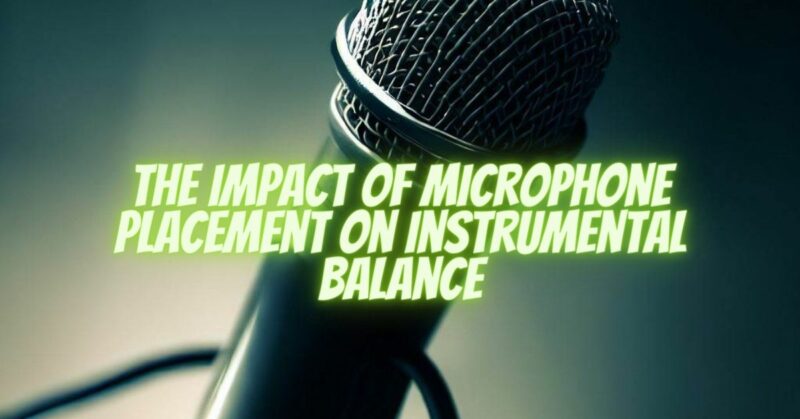When it comes to capturing the perfect instrumental balance in recordings, the placement of microphones plays a crucial role. Whether you’re recording a band, an orchestra, or a solo instrumentalist, understanding how microphone placement affects the overall sound and balance is essential for achieving professional-quality recordings. In this article, we explore the fascinating world of microphone placement and its profound impact on instrumental balance. Get ready to uncover the secrets to capturing the harmonious blend of instruments and creating captivating audio productions.
- The Role of Microphone Placement: Microphone placement directly influences the balance of instruments in a recording. It determines the relative levels of each instrument, the tonal characteristics captured, and the spatial representation of the soundstage. Proper microphone placement can enhance the clarity, definition, and overall impact of individual instruments while ensuring a cohesive and well-balanced mix.
- Understanding Instrument Characteristics: Before diving into microphone placement techniques, it’s crucial to understand the characteristics of the instruments you’re recording. Different instruments have distinct sound projection patterns, frequency ranges, and tonal qualities. Familiarize yourself with the unique sonic properties of each instrument to guide your microphone placement decisions.
- Microphone Techniques for Instrumental Balance: a. Spaced Pair Technique: Placing microphones a few feet apart in front of the instrument ensemble to capture a balanced stereo image. This technique works well for capturing the overall sound and spatial representation of the instruments. b. XY Technique: Positioning two microphones in an XY configuration to create a focused stereo image with a clear center. This technique is suitable for small ensembles or solo instruments. c. ORTF Technique: Placing a pair of microphones at an angle of approximately 110 degrees to create a spacious stereo image with good localization. This technique is often used for capturing larger ensembles. d. Close Mic Technique: Placing microphones close to individual instruments to capture their unique characteristics and achieve a more detailed and intimate sound. This technique is effective for emphasizing specific instruments in the mix.
- Experimenting with Distance and Angles: Adjusting the distance and angle of microphones can significantly impact the instrumental balance. Moving the microphone closer to an instrument will increase its prominence in the mix, while moving it farther away will provide a more blended and ambient sound. Experiment with different distances and angles to find the optimal balance and desired sonic qualities.
- Room Acoustics and Reflections: Consider the acoustics of the recording environment, as it can affect instrumental balance. Take note of room reflections and adjust microphone placement accordingly. Use absorption or diffusion panels strategically to minimize unwanted reflections and create a more balanced and controlled sound.
- Monitoring and Adjustments: While placing microphones, continuously monitor the audio through headphones or studio monitors. Make adjustments as needed to achieve the desired instrumental balance. Pay attention to the relative levels of instruments, tonal qualities, and any potential phase cancellations or imbalances.
- Post-Processing and Mixing: Even with meticulous microphone placement, fine-tuning and balancing the instruments may still be required during the mixing stage. Utilize EQ, compression, panning, and other processing techniques to further refine the instrumental balance and create a cohesive and captivating audio mix.
Conclusion:
Achieving the perfect instrumental balance in recordings requires careful consideration of microphone placement. By understanding the characteristics of the instruments, experimenting with microphone techniques, adjusting distance and angles, considering room acoustics, and making necessary post-processing adjustments, you can capture the harmonious blend of instruments and create captivating audio productions. So, unleash your creativity, explore different microphone placement techniques, and embark on a journey to capture instrumental balance that will transport listeners into a world of sonic bliss.


